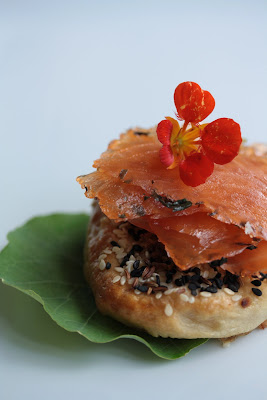
I told a few people I was making stollen. Their first response: "Have you ever had fill-in-the-blank's stollen?!!" Me: "Um, no. I didn't think I liked stollen, and so-and-so's is kinda pricey. I'm just making it for my baking challenge. I figured I'd send it to my Ome."
I didn't realize so many places in town sold it or that it had a bit of an exuberant following. The adult me was relying on the kid me's experiences of not liking the sorta dry and strangely fruity, rum-scented bread. I wasn't that excited to make it, so I was looking at this as an opportunity to hone my bread making skills, which need some work.
I didn't realize so many places in town sold it or that it had a bit of an exuberant following. The adult me was relying on the kid me's experiences of not liking the sorta dry and strangely fruity, rum-scented bread. I wasn't that excited to make it, so I was looking at this as an opportunity to hone my bread making skills, which need some work.
Since I've moved, getting yeasted doughs to rise has been a challenge. I was wanting more recipes to troubleshoot warm, non-drafty proofing zones, to figure out if my stash of instant yeast I've been storing in my fridge for several years was still viable, and to learn the cues of achieving a springy, well-kneaded dough.
To my relief this bread came together perfectly thanks to thorough directions, finding an ideal proofing spot in my oven, and using brand new packet yeast instead of the old instant stuff. I'm still learning the trick of kneading and adding appropriate amounts of flour so things don't stick to my hands. Right now, I still rely on my stand mixer and dough hook to do the messy, hard work. But success with this has given me a little more confidence to try more bread projects.
In my opinion this stollen is best eaten within a day or so that it is made. But I suppose it would still be good toasted several days after. Mine didn't last long enough to find out... After eating two good-sized portions on my own, I sectioned off the rest and packaged them to give as gifts to neighbors, coworkers and family. It was studded with Grand Marnier-soaked cherries and candied blood orange peels and limequats. Yes, limequats! Apparently kumquats are being hybridized with other fruits. My grocer had already sold out of mandarinquats. I'm hoping they'll be restocked soon. I think a medley of kumquat hybrids would make a lovely marmalade!
The 2010 December Daring Bakers’ challenge was hosted by Penny of Sweet Sadie’s Baking. She chose to challenge Daring Bakers’ to make Stollen. She adapted a friend’s family recipe and combined it with information from friends, techniques from Peter Reinhart’s book.........and Martha Stewart’s
The 2010 December Daring Bakers’ challenge was hosted by Penny of Sweet Sadie’s Baking. She chose to challenge Daring Bakers’ to make Stollen. She adapted a friend’s family recipe and combined it with information from friends, techniques from Peter Reinhart’s book.........and Martha Stewart’s
 Stollen Wreath
Stollen WreathMakes one large wreath or two traditional shaped Stollen loaves. Serves 10-12 people
¼ cup lukewarm water (110º F)
2 packages active dry yeast
1 cup milk
10 TBS unsalted butter
5½ cups (770 grams) all-purpose flour
½ cup (115 gms) sugar
¾ tsp kosher salt
1 tsp cinnamon
3 large eggs, lightly beaten
Grated zest of 1 lemon and 1 orange
2 tsp vanilla extract
1 tsp rum extract
¾ cup mixed candied citrus peel (here's a link to make your own) I used blood oranges and limequats this time
1 cup firmly packed unsweetened dried cherries
3 TBS Grand Marnier
1 cup flaked almonds
Melted unsalted butter for coating the wreath
Confectioners’ sugar for dusting wreath
Directions:
In a small bowl, soak the cherries in the Grand Marnier and set aside.
To make the dough:
Pour ¼ cup warm water into a small bowl, sprinkle with yeast and let stand 5 minutes. Stir to dissolve yeast completely.
In a small saucepan, combine 1 cup milk and 10 tablespoons butter over medium - low heat until butter is melted. Let stand until lukewarm, about 5 minutes.
Lightly beat eggs in a small bowl and add the vanilla and rum extracts.
In a large mixing bowl, stir together the flour, sugar, salt, cinnamon, orange and lemon zests.
Then stir in the yeast/water mixture, eggs and the lukewarm milk/butter mixture. This should take about 2 minutes. It should be a soft, but not sticky ball. When the dough comes together, cover the bowl with either plastic or a tea cloth and let rest for 10 minutes.
Add in the candied citrus peel, soaked cherries and almonds and mix with your hands or on low speed in the stand mixer to incorporate.
Sprinkle flour on the counter, transfer the dough to the counter, and begin kneading (or mixing with the dough hook) to distribute the fruit evenly, adding additional flour if needed. The dough should be soft and satiny, tacky but not sticky. Knead for approximately 8 minutes (6 minutes by machine). The full six minutes of kneading is needed to distribute the dried fruit and other ingredients and to make the dough have a reasonable bread-dough consistency. You can tell when the dough is kneaded enough – a few cherries will start to fall off the dough onto the counter because at the beginning of the kneading process the dough is very sticky and the cherries will be held into the dough but when the dough is done it is tacky which isn't enough to bind the outside cherries onto the dough ball.
Lightly oil a large bowl and transfer the dough to the bowl, rolling around to coat it with the oil. Cover the bowl with plastic wrap. Put it in the fridge overnight. The dough becomes very firm in the fridge (since the butter goes firm) but it does rise slowly. The raw dough can be kept in the refrigerator up to a week and then baked on the day you want.
Shaping the dough and baking the wreath:
Let the dough rest for 2 hours after taking out of the fridge in order to warm slightly. Line a sheet pan with parchment paper.
Punch dough down, roll into a rectangle about 16 x 24 inches and ¼-inch thick. Starting with a long side, roll up tightly, forming a long, thin cylinder.
Transfer the cylinder roll to the sheet pan. Join the ends together, trying to overlap the layers to make the seam stronger and pinch with your fingers to make it stick, forming a large circle. You can form it around a bowl to keep the shape.
Using kitchen scissors, make cuts along outside of circle, in 2-inch intervals, cutting 2/3 of the way through the dough. Twist each segment outward, forming a wreath shape. Mist the dough with spray oil and cover loosely with plastic wrap. Proof for approximately 2 hours at room temperature, or until about 1½ times its original size.
Preheat oven to 350°F with the oven rack on the middle shelf. Bake the stollen for 20 minutes, then rotate the pan 180 degrees for even baking and continue to bake for 20 to 30 minutes. The bread will bake to a dark mahogany color, should register 190°F in the center of the loaf, and should sound hollow when thumped on the bottom.
Transfer to a cooling rack and brush the top with melted butter while still hot. Immediately tap a layer of powdered sugar over the top through a sieve or sifter. Wait for 1 minute, then repeat with another layer of butter and sifted sugar over the first. Wait a minute and then coat with butter and sugar for a final time. The bread should be coated generously with the powdered sugar.
Let cool at least an hour before serving. When completely cool, store in a plastic bag. Or leave it out uncovered overnight to dry out slightly, German style.
The stollen tastes even better in a couple of days and it toasts superbly.
Storage
The more rum and the more coatings of butter and sugar you use the longer it will store. Stollen freezes beautifully about 4 months, stores well for 2 weeks covered in foil and plastic wrap on the counter at room temperature, or for one month in the refrigerator well covered with foil and plastic wrap.
In a small bowl, soak the cherries in the Grand Marnier and set aside.
To make the dough:
Pour ¼ cup warm water into a small bowl, sprinkle with yeast and let stand 5 minutes. Stir to dissolve yeast completely.
In a small saucepan, combine 1 cup milk and 10 tablespoons butter over medium - low heat until butter is melted. Let stand until lukewarm, about 5 minutes.
Lightly beat eggs in a small bowl and add the vanilla and rum extracts.
In a large mixing bowl, stir together the flour, sugar, salt, cinnamon, orange and lemon zests.
Then stir in the yeast/water mixture, eggs and the lukewarm milk/butter mixture. This should take about 2 minutes. It should be a soft, but not sticky ball. When the dough comes together, cover the bowl with either plastic or a tea cloth and let rest for 10 minutes.
Add in the candied citrus peel, soaked cherries and almonds and mix with your hands or on low speed in the stand mixer to incorporate.
Sprinkle flour on the counter, transfer the dough to the counter, and begin kneading (or mixing with the dough hook) to distribute the fruit evenly, adding additional flour if needed. The dough should be soft and satiny, tacky but not sticky. Knead for approximately 8 minutes (6 minutes by machine). The full six minutes of kneading is needed to distribute the dried fruit and other ingredients and to make the dough have a reasonable bread-dough consistency. You can tell when the dough is kneaded enough – a few cherries will start to fall off the dough onto the counter because at the beginning of the kneading process the dough is very sticky and the cherries will be held into the dough but when the dough is done it is tacky which isn't enough to bind the outside cherries onto the dough ball.
Lightly oil a large bowl and transfer the dough to the bowl, rolling around to coat it with the oil. Cover the bowl with plastic wrap. Put it in the fridge overnight. The dough becomes very firm in the fridge (since the butter goes firm) but it does rise slowly. The raw dough can be kept in the refrigerator up to a week and then baked on the day you want.
Shaping the dough and baking the wreath:
Let the dough rest for 2 hours after taking out of the fridge in order to warm slightly. Line a sheet pan with parchment paper.
Punch dough down, roll into a rectangle about 16 x 24 inches and ¼-inch thick. Starting with a long side, roll up tightly, forming a long, thin cylinder.
Transfer the cylinder roll to the sheet pan. Join the ends together, trying to overlap the layers to make the seam stronger and pinch with your fingers to make it stick, forming a large circle. You can form it around a bowl to keep the shape.
Using kitchen scissors, make cuts along outside of circle, in 2-inch intervals, cutting 2/3 of the way through the dough. Twist each segment outward, forming a wreath shape. Mist the dough with spray oil and cover loosely with plastic wrap. Proof for approximately 2 hours at room temperature, or until about 1½ times its original size.
Preheat oven to 350°F with the oven rack on the middle shelf. Bake the stollen for 20 minutes, then rotate the pan 180 degrees for even baking and continue to bake for 20 to 30 minutes. The bread will bake to a dark mahogany color, should register 190°F in the center of the loaf, and should sound hollow when thumped on the bottom.
Transfer to a cooling rack and brush the top with melted butter while still hot. Immediately tap a layer of powdered sugar over the top through a sieve or sifter. Wait for 1 minute, then repeat with another layer of butter and sifted sugar over the first. Wait a minute and then coat with butter and sugar for a final time. The bread should be coated generously with the powdered sugar.
Let cool at least an hour before serving. When completely cool, store in a plastic bag. Or leave it out uncovered overnight to dry out slightly, German style.
The stollen tastes even better in a couple of days and it toasts superbly.
Storage
The more rum and the more coatings of butter and sugar you use the longer it will store. Stollen freezes beautifully about 4 months, stores well for 2 weeks covered in foil and plastic wrap on the counter at room temperature, or for one month in the refrigerator well covered with foil and plastic wrap.


























 To make the doughnuts:
To make the doughnuts:






















